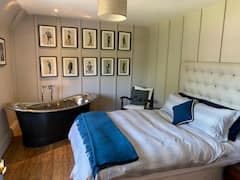Vindolanda, in Northumberland UK, is a 2,000 year old Roman frontier fort on the famous Hadrian’s Wall, built by Emperor Hadrian. It is said to have been used to keep out the marauding Scots and mark the boundary of the mighty Roman Empire. The site and museum there are the result of the life’s work of generations of the Birley family who started the site excavations in 1929 and now live and work there.
The site, high up in the stunning Northumberland hills, is a charitable trust and you can wander about the stone remains of the fort and its domestic buildings and see how people lived back then. In the summertime you can watch some of the real live excavations which take place there every year.
The fort you see today is still growing in size as new parts are discovered under the farmland. It was built on top of other earlier forts and it was the constant renewal of the site which helped to create the special anaerobic conditions which have preserved the artifacts so well.
The Museum

At the bottom of the hill through some charming gardens with a small replica of a Roman Temple, you will find the compact and very accessible museum where you can marvel at the many discoveries unearthed from the site. Here you will find Vindolanda’s most famous treasures – the Vindolanda tablets discovered only in the past decade. These tablets are perfectly preserved notes and letters from people from Roman times written on very thin pieces of wood.
Each tablet is about the size of a modern postcard. The writing was done with a pen made from a reed and black ink. The tablets were then folded over to protect the writing and the address was written on the outside like a letter. They document business transactions, lists of things that have been ordered, like socks and beer and provisions, and there is even a birthday party invitation. Some of the original tablets are here in Northumberland but the rest are in the British Museum. They are kept in a cabinet with a specially regulated atmosphere so they don’t deteriorate. They are in Latin obviously, but you can read the translations and the daily details revealed are quite fascinating.
There is also a very nice cafe (they do a mean cheese and onion toastie) and a lovely shop with first-class fridge magnets and plastic armour for the younger visitor!
What else is in the museum?

Other things to see in the museum include lots of jewellery, some set with imported precious stones, pottery, many coins, and even thousands of ancient shoes. The shoes give some indication of the build of the wearers and many of the shoes are a size thirteen and larger so the soldiers stationed here were big strong men. They were not Italians but professional fighters from countries like France, the Netherlands and Belgium. One military tribe, the Batavians, who were part of the Roman army, were of Germanic origin, and were accomplished horsemen. They were said to have been able to swim with their horses in full armour. Always handy for a surprise attack! These auxiliary soldiers had to sign up to the Roman army for 25 years. However, if they were still alive after that, they were allowed to marry and become Roman citizens!
The Roman Army Museum

The Roman Army Museum is 7 miles (11 km) from Vindolanda and explains in more detail about the lives of these exceptional soldiers commissioned into the most famous army of all time. The museum is an interactive experience which is very informative and also lots of fun. It brings to life what these soldiers would have experienced on this northernmost frontier barrier of the Roman Empire. There is a hologram of the centurion Africanus who is trying to recruit new soldiers, and an award-winning 3D film ‘Edge of the Empire’ which gives us an eagle’s eye view of how the wall may have looked in its heyday when garrisons were positioned at every mile or so along the route.
Soldiers in the Roman army were drawn from all over the world and a group of specialist archers, the Syrians, also became part of the British garrison. You can even try your hand with one of their bows - their accuracy was legendary.
You might be interested in these Airbnbs!
History comes to life at Vindolanda
Hadrian’s wall itself was made mainly of stone, although quite a length of it was built from turf, earth and timber. It is commonly thought that Hadrian built the wall to keep out the marauding Scots but it may also have been a bit of a vanity project for him to show the extent of his power. No one is really sure. Vindolanda and the Roman Army Museum make a great day out - they are a window to English history and they are open all year round. Concealed beneath farmers’ fields for centuries, Vindolanda has a personal and very friendly feel and is in an absolutely stunning location. It is a huge site and continues to provide a fascinating gateway to our past with still many more secrets yet to be discovered. Bringing history to life, a visit to Vindolanda is a special experience you will not easily forget.
History
Get Trip101 in your inbox
Unsubscribe in one click. See our Privacy Policy for more information on how we use your data




















Create an account to